Kabul:Afghan police raided yet another guerrilla general purpose and 500 pounds on and fired cannon rounds at Taliban fighters battling NATO forces near here.
*****
Asadabad, Asadabad District, Kunar Province: French Air Force M2000 Mirages, US Air Force A-10s and an Air Force B-1B Lancer attacked guerrillas fighting US troops near this town, the capital of Kunar Province. The M2000Ds dropped GBU-12's on guerrilla positions.
The Asadabad District is 100% Pashtun. 40% of the district's homes remain destroyed from the Soviet War. Almost all owners wish to rebuild but most are not able to due to both the increased size of families who fled to refugee camps and a lack of money. 80% of the population here is getting their water straight from the Kunar River which flows through the district, but it is utterly polluted.
Nevertheless, some residents walk up to 1 - 1 1/2 miles to acquire this terrible water. Wheat, rice, sugarcane and vegetables are all grown here, but most of the district is mountainous, so there is not enough cultivable land for the population.
Only 25% of the population owns land, and the other 75% are basically landless peasants or wage workers. As you can see, feudal relations remain here in Kunar. For work, many people either engage in forestry (a process which is causing terrible deforestation here) or go to Iran or Pakistan for work.
In addition, the Kunar River is constantly flooding, a process which is washing away more and more farmland. There is a serious need to build some dikes to control this mad river.
The city of Asadabad has 1 hospital and 1 medical clinic but that is not enough for the needs of the district's population. Many patients come from as far as 15-18 miles away, and quite a few die along the way.
Incredibly, people from as far away as Nuristan Province actually utilize this hospital due to an utter lack of facilities in their province. Only 2 new health facilities have been built since the fall of the Taliban. Thanks Bush!
The education picture here is somewhat better. There are 25 female teachers and 2,800 girl students, but only 20% of the population is even literate, a ridiculously low figure. There are 23 schools but all of them lack such things as chairs, benches and tables. In other words, sit on the floor!
There are actually no real classrooms at all, as all classes are either held in mosques or in the "open-air schools" that are a hallmark of Bush's Afghan occupation. This is Bush's version of No Child Left Behind for Afghanistan.
The general picture of Asadabad District is fairly good for an Afghan district, but there are serious problems with deforestation, feudal land relations, river flooding, water pollution and lack of medical facilities. River flooding is one of the most pressing problems and needs immediate work. A couple of villages have almost completely washed away recently.
*****
Thursday, November 16
Payenda Khel Neighborhood, Kabul, AM: US forces raided several compounds here, killing 1 guerrilla and arresting 4 more. Afghan and US-led coalition forces killed one terrorist and arrested four others.
Now Zad, Now Zad District, Helmand Province: Royal Air Force Harrier GR-7s fired rockets at Taliban forces fighting British troops near here.
Kandahar: US Air Force A-10 Thunderbolt IIs attacked Taliban fighters battling NATO forces near here.
*****
Lashkar Gah, Lashkar Gah District, Helmand Province: US Navy F/A-18Es attacked Taliban forces battling British troops near this town, the capital of Helmand. The Lashkar Gah District is 60% Pashtun, 20% Balochi and 20% "other", including Uzbeks, Hazara, Tajiks, Sikhs and even Hindus. Of the last listed, Tajiks are the most numerous.
This is one of the only places in Afghanistan that has a significant presence of Sikhs and Hindus anymore. The heterodox nature of this district has to do with the presence of the capital here, to which many ethnic minorities have migrated in search of work which was not available in their drought-stricken provinces. The Baloch are present in Southern Helmand in small numbers.
This district is blazing hot - in the summer it averages 122 F! It's rather cool in the wintertime, with an average temperature of 50 F. Water is actually very plentiful here, believe it or not. There are 5,000 wells here, and all of them are functioning! In Afghanistan, that is nothing short of miraculous. No one has to walk more than 200 yards to collect water, which is also amazing in Afghanistan.
As usual in Afghanistan, there is no real sewage system. Waste water simply flows into canals, which results in a lot of preventable disease. Wheat, corn, cotton, apricots, pomegranates, grapes, tomatoes, potatoes, cauliflower, onions, turnips and maize are all grown here, using both irrigated and rain-fed lands but the rain-fed lands are all dry right now. The harvest has been poor lately for a variety of reasons.
Nevertheless, there is a very large amount of arable land in this district compared to the rest of the country, and 100% of this arable land is being farmed! This is also almost unheard of in Afghanistan. There are a large number of domestic livestock here, including cattle, sheep, goats and camels. Most families have retained most of their livestock in recent years, which is also unheard of in Afghanistan.
Although the agricultural sector is in remarkably good shape, most of the roads here, including the main road, are partially ruined. Medical care is widely available here compared to the rest of the country. There is a 200-bed hospital in Lashkar Gah that treats 500 patients a day, with 49 male and 7 female (!) doctors, in addition to 40 pharmacies in the city.
This is a very large number of beds, doctors and pharmacies for an Afghan district. Nevertheless, despite the positive numbers, people outside the city are mostly using facilities inside the city, and there are still not enough facilities and personnel to deal with all the rural folks coming into town needing care.
There are quite a few teachers and schools here, but most of the teachers are men. There are actually 8 female primary school teachers, which is surprising in this conservative area.
There are about 8,750 boys and 850 girls in school. It's amazing that there are any girls in school here at all, but as you can see, boys outnumber girls by 10-1. By high school, the ratio climbs to nearly 20-1. Some of these school buildings are partly or completely wrecked, and some schools are actually being held in private homes.
The teachers are professionally trained and UNICEF is providing books. In many Afghan districts, there are no books at all, and many or most classes are held outdoors, so the education picture here is actually positive. In this ultra-conservative district, an amazing 20% of women are now working after the Taliban dirt was swept away. The remaining 80% are confined to the home in the Pashtun tradition.
Girls marry her at an average age of 16, which is the norm in most of Afghanistan. 90% of the boys are in school and only 10% are working, which is an excellent statistic for this country. The residents here are actually progressive about schooling and wish to educate their kids, but there some villages lack schools.
All in all, the Lashkar Gah District paints a surprisingly happy picture in most areas compared to the rest of the country, and especially considering that it is a part of the ultraconservative Pashtun Helmand Province.
*****
Wednesday, November 15
4 1/2 miles north of Gereshk, Nahri Sarraj District, Helmand Province: A speeding van approached a British checkpoint here and refused to slow down. Soldiers fired on the van, killing 2 Afghan civilians and wounding 1 more. This is in the sparsely-settled desert north of the Helmand River. Most people in this district live right along the Helmand.
****
Gulbahar, Kapisa Province: Police chased a suicide bomber in this good-sized city. As he ran from the police, he ran into a butcher shop and detonated himself, killing himself and wounding a butcher. Gulbahar (map) is located about 43 1/2 miles north of Kabul. Although the article says that Gulbahar is located in Parwan, it is actually just across the border in Kapisa Province.
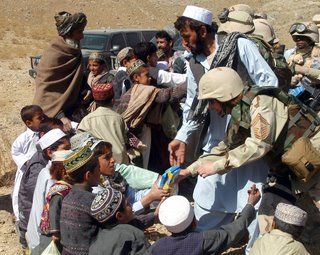 US forces handing out aid to Afghans in Parwan Province.
US forces handing out aid to Afghans in Parwan Province. Bridge building by US forces in Tokchi village in Parwan Province. There is definitely more vegetation here, at least by the rivers, in this northern province.
Bridge building by US forces in Tokchi village in Parwan Province. There is definitely more vegetation here, at least by the rivers, in this northern province.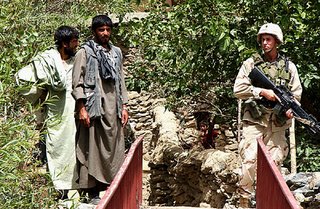 A bridge built by US forces in the Shenwary District of Parwan Province. The heavy vegetation at least here by the river makes this area look almost like a jungle.
A bridge built by US forces in the Shenwary District of Parwan Province. The heavy vegetation at least here by the river makes this area look almost like a jungle.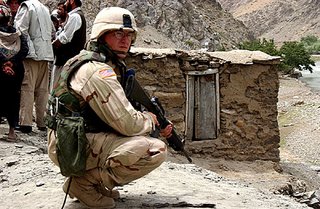 A US soldier on patrol in the Shenwary District of Parwan Province. The rivers run pretty high amidst steep mountains, as you can see in this photo.
A US soldier on patrol in the Shenwary District of Parwan Province. The rivers run pretty high amidst steep mountains, as you can see in this photo.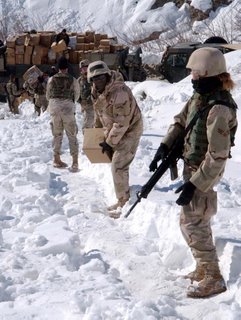 US troops handing out supplies in wintertime in Parwan Province. As you can see, it snows quite heavily up here in the Hindu Kush Mountains. These mountains were named Hindu Kush (or Hindu Killer) after one of the Muslim conquerors of India took huge numbers of Indian Hindu slaves from India back to Arab lands. Along the way, in the middle of Winter, an incredible 100,000 slaves perished in a single night in these killer mountains. Since then, the range has been called Hindu Kush.
US troops handing out supplies in wintertime in Parwan Province. As you can see, it snows quite heavily up here in the Hindu Kush Mountains. These mountains were named Hindu Kush (or Hindu Killer) after one of the Muslim conquerors of India took huge numbers of Indian Hindu slaves from India back to Arab lands. Along the way, in the middle of Winter, an incredible 100,000 slaves perished in a single night in these killer mountains. Since then, the range has been called Hindu Kush.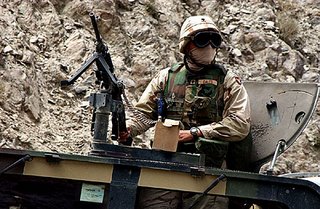 US soldier on patrol in the Shenwary District of Parwan Province. He looks creepy all bundled up like this - you can't see any skin on his face.
US soldier on patrol in the Shenwary District of Parwan Province. He looks creepy all bundled up like this - you can't see any skin on his face.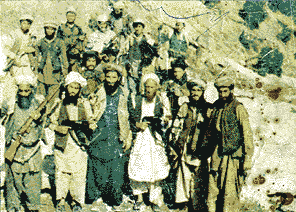 Mujahedin in the Panjshir Gorge in Parwan Province in a vintage photo from the Soviet War. This Gorge was the headquarters of Shah Massoud, ethnic Tajik leader of the Northern Alliance, the so-called "Lion of the Panjshir". He was killed by Al Qaeda by suicide bombers posing as interviewers with a bomb in their video camera. This attack in Afghanistan occurred just 2 days before the 9-11 attacks on the USA and should be seen as part and parcel of that operation.
Mujahedin in the Panjshir Gorge in Parwan Province in a vintage photo from the Soviet War. This Gorge was the headquarters of Shah Massoud, ethnic Tajik leader of the Northern Alliance, the so-called "Lion of the Panjshir". He was killed by Al Qaeda by suicide bombers posing as interviewers with a bomb in their video camera. This attack in Afghanistan occurred just 2 days before the 9-11 attacks on the USA and should be seen as part and parcel of that operation.****
Khas Oruzgan, Khas Oruzgan District, Oruzgan Province: Air Force A-10 Thunderbolt IIs attacked Taliban forces fighting US troops near here.
*****
Ghazni, Ghazni District, Ghazni Province: An Air Force B-1 Lancer attacked Taliban forces fighting US troops near here, the capital of Ghazni Province.
The population of the Ghazni District (which encompasses Ghazni City plus a number of outlying villages) is interesting for this unstable mostly-Pashtun province in that Pashtuns are a minority here. The city is 50% Tajik, 25% Pashtuns, 20% Hazara and 5% Hindu. That translates to a Hindu population of about 4,500, which is pretty shocking for post-Taliban Afghanistan.
The water situation here is good, with 100% of the population of the city having access to water. However, some nearby villages still have shortages. There is a fair amount of farmland here, with wheat, vegetables and some fruit orchards being cultivated. 80% of the arable land is being farmed, which is quite good for drought-stricken Ghazni.
However, as is common in many urban areas in the world, housing is taking over agricultural land. Frighteningly, 30% of the population is described as "no income". But under George Bush's capitalism, that's just tough luck, right? There is one hospital and 7 clinics in the city but there are not enough facilities for the population.
Since George Bush took over Afghanistan, he has not built one single medical facility here - in other words, things are just as they were under the Taliban. Can anyone say, "(George Bush's) Capitalism is bad for your health?"
Bush has not stopped with clinics though, he has applied similar capitalist ethics to education, where not 1 new school has been built. The education system, then, is the same as under the Taliban. There are 14 female teachers and there are 800 girls in school, which are pretty good figures for Ghazni, but may have to do with the 75% non-Pashtun population here.
The education system here has serious problems, with lack of professional teachers, school facilities, standardized curriculum, decent classrooms and supplies.
All in all, the Ghazni District looks pretty good for Ghazni Province but that is not saying much at all. Schools and medicine continue to be problem areas.
******
Lashkar Gah, Helmand Province: Royal Air Force GR-7 Harriers fired rockets on Taliban positions near here.
Tuesday, November 14
****
Afghanistan: One of those arrested in a raid last week in which 6 Al Qaeda operatives were seized was a high-level Al Qaeda operative who was among those who escaped from Bagram Prison in July 2005.
Abu Nasir al-Qahtani was arrested along with 5 Pakistani and Saudi nationals. Grenades, armor-piercing rounds, AK-47's, other military equipment and a surveillance camera with footage of US military bases was seized in the raid.
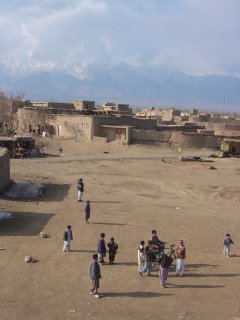 Kids playing near Bagram Air Base. It was from the prison at this base that 5 Al Qaeda operatives escaped in July 2005. Note the spectacular soaring peaks in the background.
Kids playing near Bagram Air Base. It was from the prison at this base that 5 Al Qaeda operatives escaped in July 2005. Note the spectacular soaring peaks in the background. Local Afghans arriving at work at the Bagram Airbase, the main US base in Afghanistan. Many Afghans work here.
Local Afghans arriving at work at the Bagram Airbase, the main US base in Afghanistan. Many Afghans work here.****
*****
Qalat, Qalat District, Zabul Province: US Air Force A-10 Thunderbolt IIs fired cannon rounds on Taliban positions near here, the capital of Zabul Province.
The Qalat District, a hostile district with an entrenched insurgency, is made up of 95% Pashtuns and 5% Tajiks. The temperature here is very extreme, with summers averaging a very hot 99 F, and winters averaging a very, very cold -4 F. About 30% of the homes here were destroyed in the Soviet War.
There is a serious water problem here. Water is available in Qalat city but in many outlying villages, all of the wells are now dry. 40% of the water sources are now dry. In the outlying areas, people walk an average of 1 mile to get water twice a day. After they get to the source, they must wait in line for about 40 minutes in order to get water. Worse than the DMV! Gads, what a waste of time.
As usual in Afghanistan, there is no real sewage system, and waste water just runs free in the streets, as it did in the Middle Ages in Europe when this situation set off the Black Death or Black Plague.
The main crop grown here is wheat, and both irrigated and rain-fed lands are utilized. All of the rain-fed lands are presently dry, and the harvest in general is poor. In total, only 50% of arable land is being cultivated. Other crops are grapes, almonds, watermelons, tomatoes, turnips, okra and onions.
The farmlands near the Tarnak River, which runs through the district, are in good shape, but others are not necessarily doing well. Consequently, there is internal migration occurring here, as people flee devastated outlying villages for the villages closer to the river. Most fruit trees here are destroyed by fungi before they can produce much of a crop.
Before the drought, each family here owned an average of 30 herd animals, including sheep, cattle, goats and camels. An unbelievable 90% of these animals have been killed by the drought! The main road here is partly wrecked and the rest of the roads are often muddy and barely passable. Many bridges need to be rebuilt.
There is a lot of unemployment here due to the drought devastating the agricultural system. There is a good, well-supplied hospital in the city with 60 beds and a lone female doctor amidst the male doctors. There is also a Basic Health Center. These 2 facilities treat 280 patients a day.
In the many villages of this large district, incredibly, there are absolutely no medical clinics at all! Nor has George Bush bothered himself to build a single one, either.
There are 11 schools in this district, but in general, they are in poor condition. The high schools have water but no bathrooms and the primary schools have neither. Where do the kids go to the bathroom anyway?
One great thing about this district is that there has been a major effort to build girls high schools here. Consequently, there are actually slightly more female high school teachers than males, and there are somewhat more girl high school students than boy students. In Afghanistan, that is simply amazing. Bizarrely, there is a serious lack of primary schools for girls. Does that make any sense?
Despite these rosy spots, the education system in general here is bad, with only 20% of the children in school and the rest either at home or working either in the fields or in homes and shops.
Most women here are confined to their homes in the Pashtun tradition known as purdah and do not take part in community decision-making. However, 10% of the women here work outside the home, which is actually quite a good figure for an ultraconservative Pashtun region. The average marriage age for girls here is an incredible 10 years old!
I suspect John Mark Karr will be showing up in this district shortly, eh?
In overview, the Qalat District has significant problems, about which just about zero has been done by the US "liberators". Drought is badly hammering the district, and a number of outlying districts with dry fields and no water are being abandoned by people either moving to Qalat or to well-watered villages near the Tarnak River.
The many smaller villages here do not have one single medical clinic! Only 20% of the kids are in school and the rest are working in a Medieval situation. A few women are working, which is interesting for a misogynist Pashtun region. The average marrying age of girls at 10 years is simply appalling!
In all, the Qalat District really needs a lot of work.
*****
Now Zad, Now Zad District, Helmand Province: Air Force A-10 Thunderbolt IIs and US Navy F/A-18 Hornets attacked Taliban forces in contact with British troops near here.
Monday, November 13
Shindand District, Herat Province, 2:30 PM: The Taliban detonated a car bomb at the entrance of a military base here, killing the attacker but not causing any other casualties. This district stretches to the south and west of Herat, the capital of Herat Province, and borders Farah Province to the south.
*****
Afghanistan: A new report was issued by the Joint Coordination and Monitoring Board, a group of Afghan and foreign officials in charge of implementing the Afghanistan Compact. The Compact is a 5-year reconstruction and development plan that was signed in February.
The report said guerrillas launched more than 600 attacks a month in Afghanistan in September, more than 20 per day (!), up from 300 a month in March. So the rate of attacks has doubled from 10 a day to 20 a day - or nearly one an hour - in 6 months. More than 3,700 people have died in the fighting this year.
Last year, there were only about 130 insurgent attacks a month, or 4 per day. The rate of attacks increased by 250% in March compared to 2005, and by September, attacks were occurring at 5 times the rate of 2005.
*****
Khas Oruzgan, Khas Oruzgan District, Oruzgan Province: US Navy F/A-18 Hornets dropped GBU-12's on Taliban forces near here.
Kandahar: US Navy F/A-18 dropped GBU-12 and GBU-38 bombs on and fired cannon rounds at Taliban forces fighting NATO forces near here. In the same bombing run, British Royal Air Force GR-7 Harriers fired enhanced Paveway II munitions and rockets on the Taliban.
Musah Qaleh, Musah Qaleh District, Helmand Province: US Air Force A-10 Thunderbolts fired cannon rounds on Taliban positions near here. There is supposedly a truce here between British forces and the Taliban, but I guess not.
Sunday, November 12
*****
Kunduz, Night: RPG attack on a 3-vehicle joint German-Afghan patrol wounded 2 Afghan policemen but no German troops were hurt.
The city of Kunduz, the capital of the province, was the last major northern city held by the Taliban before they were overthrown by the Northern Alliance on November 26, 2001.
Before the fall, Pakistani planes airlifted 5,000 Taliban and Al Qaeda fighters out of the town. Of those, 2,500 were Pakistanis, including Pakistani civilians, soldiers and intelligence officers. The rest were Afghans, Uzbeks, Chechens and Arabs.
Pakistani support for the Taliban and even Al Qaeda have always been more about the deadly realpolitik game it plays with India than anything else. For instance, India supported the Northern Alliance and supports Karzai. Hence, Pakistan supports the Taliban. All roads in the India-Pakistan conflict lead back to Kashmir, the flash point between India and Pakistan since 1947.
While India holds Kashmir hostage to Indian imperialism, Pakistan feels that Kashmir is part of Pakistan. The Kashmiris, for their own part, may just wish total independence from either state. Given the staunch anti-Taliban feelings of the people in Kunduz, it is stunning that attacks on NATO forces are occurring here.
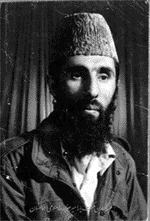 Gulbuddin Hekmatyar, leader of Hezb-i-Islami, in a vintage photo from the Soviet War. Hekmatyar is currently a fugitive fighting US forces. His fundamentalist lunatic forces received the bulk of US aid via the Pakistani intelligence ISI during that war. We are now experiencing blowback as Hekmatyar fights our own troops.
Gulbuddin Hekmatyar, leader of Hezb-i-Islami, in a vintage photo from the Soviet War. Hekmatyar is currently a fugitive fighting US forces. His fundamentalist lunatic forces received the bulk of US aid via the Pakistani intelligence ISI during that war. We are now experiencing blowback as Hekmatyar fights our own troops.While Communists were liberating Afghan women from centuries of repression and terror, the US was funding psychopathic misogynists like Hekmatyar with the minds of Ted Bundy. Shows you how America feels about women's rights! Hekmatyar has roots in the Afghan Muslim Brotherhood back in the late 1960's.
Back in those days, his dirty followers specialized in murdering their Communist and Leftist enemies. While an engineering student at the University of Kabul, this charming man, America's best friend in Afghanistan in the 1980's, specialized in the chivalrous habit of tossing acid into the faces of unveiled female students. Nice guy! Hekmatyar is a Pashtun from the small Pashtun minority in Kunduz Province.
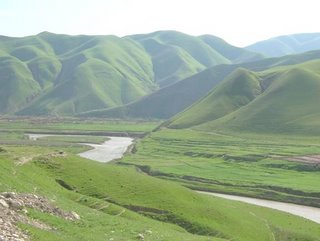 A stunningly beautiful scene in Kunduz Province. As you can see, it is much wetter and greener up here, with rivers that actually flow much of the year. That scene could be of Scotland if we did not know better .
A stunningly beautiful scene in Kunduz Province. As you can see, it is much wetter and greener up here, with rivers that actually flow much of the year. That scene could be of Scotland if we did not know better .*****
Gereshk, Nahri Sarraj District, Helmand Province: Air Force A-10 Thunderbolt IIs and Royal Air Force GR-7 Harriers attacked Taliban fighters battling British troops near here.
Sangin, Sangin District, Helmand Province: RAF GR-7s attacked Taliban fighters battling British troops near here.
Deh Rawood, Deh Rawood District, Uruzgan Province: US Navy F/A-18 Hornets attacked Taliban troops battling NATO forces near here.
Now Zad, Now Zad District, Helmand Province: Navy F/A-18s fired cannon rounds on Taliban positions battling British troops near here.
Kandahar: RAF GR-7s and US Air Force A-10s, a MQ-1 Predator and a B-1B Lancer and Navy F/A-18s attacked Taliban forces battling NATO forces near here. The B1-B dropped a GBU-31 on, the F/A-18s dropped a GBU-38 on and the Predator fired a Hellfire missile at on Taliban targets.
Lashkar Gah, Lashkar Gah District, Helmand Province: US A-10s also attacked Taliban forces fighting British troops near here, the capital of Helmand.
Saturday, November 11
Bermal District, Paktika Province: US and Afghan forces said they killed 60 guerrillas in heavy fighting here. 4 Afghan and 4 US troops were wounded in the fighting. 25 heavy machine guns and some AK-4's were seized.
Paktika Province: Afghan forces arrested 2 guerrillas who were planting roadside bombs here.
Now Zad, Now Zad District, Helmand Province: US Navy F/A-18Cs dropped GBU-12s and fired cannon rounds at Taliban fighters fighting British troops near here. US F/A-18Fs also dropped GBU-12s on enemy positions in the same bombing mission.
Friday, November 10
Malik Shahi District, Paktika Province: US and Afghan forces killed 25 guerrillas here in fighting that extended over 2 days. Air power was utilized. There is no such district as the Malik Shahi District.
Kandahar: A Air Force Predator fired Hellfire missiles on Taliban targets near here.
****
Kundi Ghar, North Waziristan, Pakistan: Air Force A-10 Thunderbolts and a B-1B Lancer and U.S. Navy F/A-18Cs and F/A-18Fs attacked guerrillas fighting NATO troops near here. The A-10s fired cannon rounds at and the B-1B dropped GBU-31s and GBU-38s on guerrilla positions.
Kundi Ghar is a border post at 10,380 feet, on the border between North Waziristan and Paktia Province, in an Al Qaeda and Taliban-overrun area called the Shawal. Osama bin Laden and Ayman al-Zawahiri were long thought to be hiding here, but I think in recent days they have moved north to the area of Nuristan and Kunar Provinces in Afghanistan and the Bajaur Tribal Area in Pakistan.
Articles about this terrorist-overrun border post are here and here. Photos of the post itself are here. A great photo gallery with many photos of the post and surrounding area is here.
*****
Shemika, Afghanistan: An Air Force B-1B dropped GBU-31s and GBU-38s on Taliban forces fighting NATO troops near here. Shemika cannot be found on any map.
Garmser, Garmser District, Helmand Province: US Navy F/A-18Cs dropped GBU-12's on and fired cannon rounds at Taliban fighters battling British troops near here.
Sangin, Sangin District, Helmand Province: US Navy F/A-18Es and F/A-18Fs attacked Taliban forces battling British troops near here.
Janga Kalay, Afghanistan: US Navy F/A-18Es attacked guerrillas battling NATO forces near here. Janga Kalay could not be located on any map.
Thursday, November 9
Sperwan, Panjwayi District, Kandahar Province: Early AM: Guerrillas fired 3 rockets at a Canadian base here. There were apparently no injuries. Sperwan (map) is 21 miles east of Kandahar city.
Khost Province: 2 hours after a roadside bomb attack here, a group of Afghan civilians approached the hulk of a gravel truck that had been hit by the bomb. The truck exploded again, killing 1 civilian and wounding 1 more. It was not known whether or not the truck was booby-trapped.
Near Khost City, Early: Afghan and US forces raided a compound here and arrested 3 guerrillas.
Khvajeh Khezar, Afghanistan: An Air Force B-1B Lancer dropped a GBU-31 bomb on a Taliban position near here. Khvajeh Khezar could not be located on any map.
Lmasi Domande, Nad Ali District, Afghanistan: Royal Air Force GR-7 Harriers and U.S. Navy F/A-18 Hornets attacked guerrillas battling NATO forces near here. Lmasi Domande is an obscure town that is apparently located 10 miles northwest of Nad Ali (map), the capital of the district, out in the middle of the sparsely populated desert in an obscure region called Zamindavar (map).
Gereshk, Nahri Sarraj District, Helmand Province: US Navy F/A-18s attacked Taliban fighters battling British forces near here.
Wednesday, November 8
****
Dargai, Malakand District, North West Frontier Province, Pakistan, Early AM: A suicide bomber wrapped in a cloak came running onto a field where 130 recruits had gathered for training, blowing himself up inside Pakistan's main army training base here, and killing 45 soldiers in the process. There was almost no perimeter security at the base at the time of the attack, surprisingly.
This would be the Pakistani insurgents' deadliest attack yet on the Pakistani army. A suspected accomplice of the bomber was captured after the army chased him into a nearby village.
The Pakistani Taliban was suspected in what was deemed a revenge attack for the October 30 US attack on Chinagai in the Bajaur Tribal Area last month that killed over 80 people at a madrassa (see previous Roundup here for details). Rahimullah Yusufzai, a well-known Pakistani journalist, received a call from a "Pakistani Taliban" organization led by Abu Kalim Muhammad Ansari claiming responsibility for the attack.
A former student at the Chinagai madrassa was said to be the bomber in this Dargai attack. Pakistani sources say that one theory is that the US attacked this madrassa because of intelligence showing that Ayman Al-Zawahiri was in the madrassa at the time of the attack. That intel was false, but the madrassa was definitely an Al Qaeda training base.
Another theory is that US forces opposed peace talks aimed at fashioning a deal in Bajaur along the lines of recent pacts in the Waziristans. The deal was only hours away when the madrassa was hit and now there will be no deal.
As far as the Zawahiri theory, Zawahiri has deep ties to the Bajaur region. He has reportedly taken a Mohmand woman as one of his wives recently. She lives in the Mohmand Tribal Agency on the border with Bajaur with her father. Zawahiri reportedly made 3 visits to the area to see her in 2001.
Zawahiri was reportedly visiting relatives for Eid on January 13,2006 in the Bajaur village of Damadola (map) when the home was attacked by a US Predator missile. The strike reportedly only missed killing Zawahiri by hours. Damadola is about 11 miles east of the Afghan border and about 5 miles northwest of Khar, the capital of Bajaur. Chinagai, where the madrassa was attacked, is about 14 miles east of Damadola and 12 miles northeast of Khar.
A nice, easy to read map, with Damadola circled in red, is here. It also shows many other towns in this terrorist-infested zone.
The October madrassa attack set off waves of protests in Bajaur, many led by a cleric named Faqir Mohammad. Faqir is wanted by the US on charges of being a pro-Al Qaeda cleric who harbors Al Qaeda fighters, including Zawahiri. He has unabashed links with Al Qaeda, and boasts that he would hide bin Laden if he could.
Faqir is also said to Pakistan's most wanted man, yet despite being on both the US and Pakistan's most wanted lists, he recently gave an interview with a European news agency from Bajaur, where he was walking around in plain sight.
Prior to the October madrassa attack, NWFP Governor Jan Mohammad Orakzai had been negotiating with Faqir to fashion some sort of a truce along the lines of the recent truces in North and South Waziristan. That's all on hold now.
Dargai (map, better map here, and yet another map is here) is located east of Bajaur and 62 miles north of Peshawar.
There are many towns called Dargai in the NWFP, but the one referred to here is apparently the largest town by that name, located in the Dir District. Pakistan suspects that either Al Qaeda or a group called Tehrik-e-Nifaz-e-Shariat Mohammadi (TNSM), or the Movement for the Enforcement of Islamic Law, was also involved.
TNSM is an extremely militant Salafist group that has a very large presence in Bajaur and Malakand. It was formed in 1992 after a radical cleric, Mualana Sufi Mohammad, a leader in the Pakistani Islamist political party Jamaat-e-Islami, split from JEI.
Sufi called for a jihad against the US after the invasion of Afghanistan and led 10,000 followers into Afghanistan to fight for the Taliban. Many were killed by US air strikes and many others were captured by the Dostom's Northern Alliance and suffocated to death in containers in the far north of Afghanistan. After this defeat, Sufi and his forces went back to Malakand but the locals were supposedly furious that so many young men had been killed.
Musharaff banned the TNSM as a terrorist organization in early 2002 and had Sufi arrested. He has apparently been in prison ever since.
After the terrible earthquake hit Pakistan in October 2005, the Pakistani government's response seemed lacking, and the holes were filled by Islamist groups like TNSM and the radical Lashkar-e-Toiba (LET). The popularity of both groups soared afterwards and TNSM was given a new lease on life.
The TNSM now operates heavily in Malakand and Bajaur. Its leader is Sufi's son-in-law, Maulana Fazallulah. The madrassa hit last month was run by 2 TNSM clerics, Maulvi Faqir and Maulvi Liaqat. Liaqat and his 2 sons were killed in the October 30 attack but Faqir is still on the loose. The madrassa was funded by Maulana Sami ul-Haq, who is said to be close to Mullah Omar.
There are also suspicions that TNSM may also be involved in fighting in Afghanistan, especially in Nuristan and Kunar Provinces.
An excellent, easy to read map linked here shows Malakand, Dargai and Khar. Damadola would be about 1/2 way to the Afghan border from Mian Kala, and Chinagai is located about where Timagarha is on the map. Other well-known towns shown on this map include Dir, Peshawar and Landi Kotal.
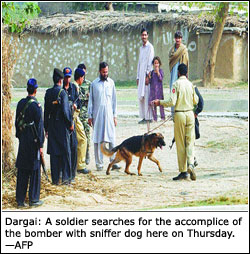 Pakistani forces search a nearby town for the accomplice of the bomber who attacked Dargai. The man fled into sugar cane fields but was captured after a while. The Pakistani Taliban took responsibility for the attack and claimed that they had another 250 fundamentalist dirtbags ready to blow themselves up. If only they would go off alone and do it and not take anyone with them!
Pakistani forces search a nearby town for the accomplice of the bomber who attacked Dargai. The man fled into sugar cane fields but was captured after a while. The Pakistani Taliban took responsibility for the attack and claimed that they had another 250 fundamentalist dirtbags ready to blow themselves up. If only they would go off alone and do it and not take anyone with them!*****
Panjwayi District, Kandahar Province, Afternoon: The Taliban battled Afghan police here. 6 Taliban were killed and 4 more were wounded. 4 more people, 1 policeman and 3 civilians, were also wounded as guerrillas ran to hide in civilian homes.
Panjwayi District, Kandahar Province, Late: Taliban forces attacked Canadian troops and Afghan police with small arms fire. Afterwards, the Coalition forces identified the Taliban position and called in air strikes, killing between 22 Taliban. Either this attack or the one above, or both, took place near Payendi, which can be surmised by the bombing report below.
*****
Shahjoy District, Zabul Province, Late: The Taliban ambushed a police convoy on the Kandahar-Kabul Highway here, killing 2 police and wounding 5 more. The Shahjoy District is 100% Pashtun. Of the 1,000 wells in this dry area, only 30% are currently functioning due to drought. Women and children gather water, but they must walk 1-3 miles to get any.
Wheat, corn, maize, beans, peas, grapes, almonds, apricots, figs, okra, eggplant, potatoes and tomatoes are all grown here, both by irrigation and by rainfall. Wheat, corn, maize, beans and peas are the main crops. The rainfall-irrigated lands are all fallow by now. 55% of the total lands are now fallow. 70% of the livestock here have been killed by the drought.
There is almost no transportation here. The main road is ruined and most of the other roads are muddy during the rainy season. Every bridge in the district is ruined. 70% of the karezes, or traditional irrigation canals, are not working.
Only 20% of the population is currently working their farmlands due to the drought. The rest go to the main bazaar in Shah Joy town, or to Qalat city, Kandahar and Helmand Provinces, Pakistan or Iran to work. There is one Basic Health Center in the district, in Shah Joy town. It suffers a serious lack of supplies and it is unsanitary.
There are a number of schools in the district, but 50% of them have no buildings and are held outdoors. Only 6 of the schools have water and toilet facilities available. The schools lack supplies. None of the girls in this district are in school, thanks to George Bush's "women's liberation" occupation of Afghanistan. In 2002, 70% of the boys are in school and the rest are working the fields with their fathers.
By early this year, most of the schools here had been shut down due to Taliban threats.
Women play no role in the community here and are basically confined to their homes.
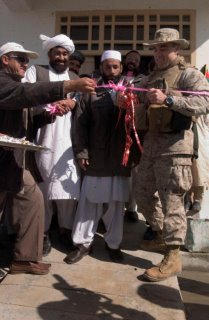 Ribbon-cutting ceremony for a clinic built by US troops in Shah Joy town. A recent Washington Post article indicated that this district is still thoroughly hostile. In some villages here, children throw stones at US forces and curse at them. The same article described Shah Joy as a district of parched olive orchards, stunted vineyards and wandering herds of camels.
Ribbon-cutting ceremony for a clinic built by US troops in Shah Joy town. A recent Washington Post article indicated that this district is still thoroughly hostile. In some villages here, children throw stones at US forces and curse at them. The same article described Shah Joy as a district of parched olive orchards, stunted vineyards and wandering herds of camels.*****
Oruzgan Khas, Oruzgan Khas District, Oruzgan Province: An Air Force RQ-1 Predator fired a Hellfire missile on a Taliban target near here.
Payendi, Panjwayi District, Kandahar Province: US Air Force A-10 Thunderbolt IIs dropped GBU-12s and general-purpose 500-pound bombs on and fired cannon rounds at Taliban positions battling Canadian forces near here.
Michene Ghar Mountain, Bermal District, Paktika Province: An Air Force B-1B Lancer dropped GBU-31's on guerrillas battling US NATO forces near here. Michene Ghar Mountain (map) is located near Mangretay below, near the border with South Waziristan and near the US base at Shkin. It is located between Garbi Mangretay (map) and Landa Katsey ( map)
Garmser, Garmser District, Helmand Province: Royal Air Force GR-7 Harriers attacked Taliban fighters battling British forces near here.
Mangretay Naray Pass, Bermal District, Paktika Province, Afghanistan: Navy F/A-18 Hornets attacked guerrillas battling US forces near here. This pass is probably located right on the Pakistani border with South Waziristan near the town of Mangretay ( map).
Tuesday, November 7
Tanai District, Khost Province, Near the Pakistani Border: A suicide attacker blew himself up near a district police chief's vehicle here. Only the bomber was killed, but the Tanai District police chief and 2 of his bodyguards were wounded.
Kabul: British singer Mylene Klass made a trip to visit British soldiers in Afghanistan, but her plane was attacked by guerrillas as it neared Kabul. The RAF had to scramble a fighter jet to escort the plane after it came under fire. The plane was actually hit by ground fire.
Mangretay, Bermal District, Paktika Province: Navy F/A-18 Hornets dropped GBU-12's on and Air Force A-10 Thunderbolt IIs dropped a general purpose 500-lb bomb on a guerrilla position here. Mangretay ( map) is located 5 miles north of the US base at Shkin and just across the Pakistani border of South Waziristan.
Armarah, Panjwayi District, Kandahar Province: US Navy F/A-18s dropped GBU-12's on Taliban forces battling Canadian troops here. Armarah (map) is located 19 miles west of Kandahar city. There is a lot of fighting going on around here these days.
Monday, November 6
15 miles southeast of Khost, Khost Province, 12:15 AM: The Taliban attacked a police post on a highway here, setting off a heavy 1-hour gun battle. 1 policeman was killed and 2 were wounded. 5 Taliban were killed. The remaining Taliban apparently fled across the border into North Waziristan.
Gereshk, Nahri Sarraj District, Helmand Province: Roadside bomb attack on an Afghan military patrol damaged an Afghan army vehicle and killed 1 Afghan army soldier.
****
Sperwan, Panjwayi District, Kandahar Province: Roadside bomb attack on a joint Canadian-Afghan patrol here killed 1 NATO soldier and wounded 2 more. Initial reports indicated that a Canadian soldier was killed.
Subsequent reports indicated that the dead soldier was actually an American Special Forces soldier, Sergeant 1st Class William R. Brown. US Special Forces troops are embedded with the Canadian troops that dominate in Kandahar Province.
*****
Qanat-e Hazra: Navy F/A-18 Hornets dropped GBU-12's on guerrilla fighters battling NATO forces near here. This town could not be located on any map.
Bermel Rod, Bermal District, Paktika Province: An Air Force B-1B Lancer attacked guerrillas battling NATO forces near here. Bermel Rod (map) is located 5 miles north of the US base at Shkin, across from the South Waziristan border. More detailed description here.
Sunday, November 5
Gereshk, Nahri Sarraj District, Helmand Province: US Air Force F-16 Fighting Falcons and a B-1B Lancer attacked Taliban fighters battling British forces near here. The B-1 dropped GBU-38's on the Taliban.
Now Zad, Now Zad District, Helmand Province: Air Force A-10 Thunderbolt IIs attacked Taliban fighters battling British forces near here.

No comments:
Post a Comment